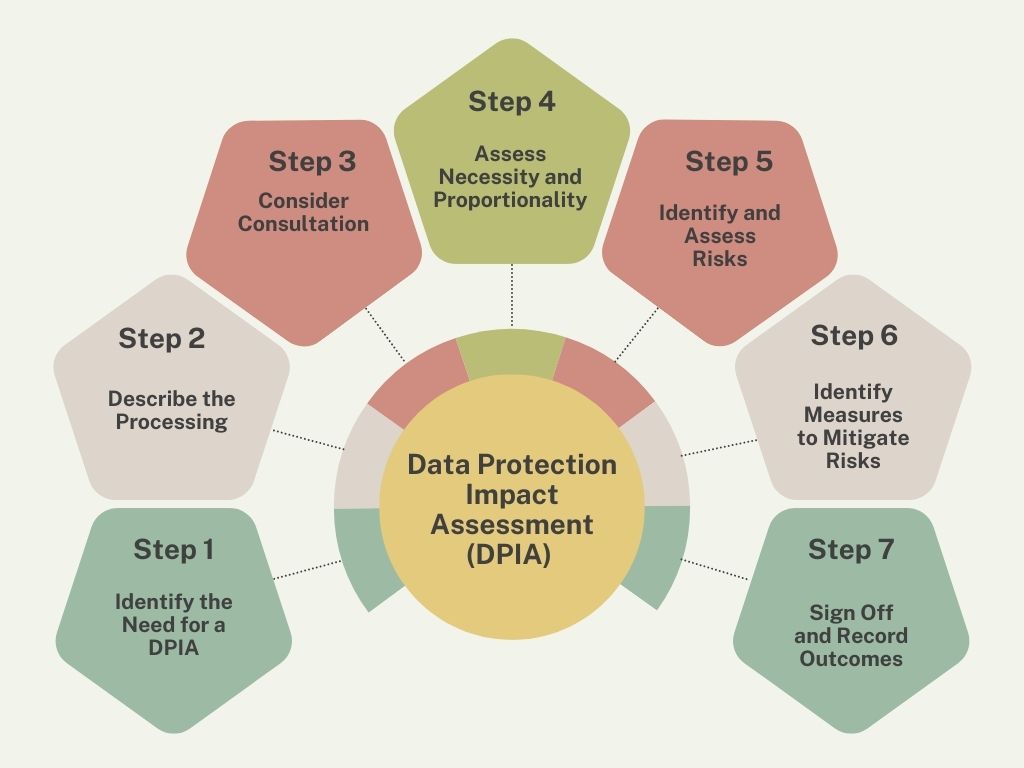A Data Protection Impact Assessment (DPIA) is a crucial process for organizations to identify and minimize data protection risks associated with their data processing activities. Here’s a step-by-step guide to conducting an effective DPIA:

Step1 : Identify the Need for a DPIA
Determine if a DPIA is necessary by assessing whether your data processing activities pose a high risk to individuals’ rights and freedoms. This may include:
– Systematic and extensive profiling
– Large-scale processing of sensitive data
– Public monitoring activities
If in doubt, it’s generally advisable to conduct a DPIA.
Step2 : Describe the Processing
Provide a detailed description of your data processing activities, including:
– Nature, scope, and context of the processing
– Types of personal data collected
– Purpose of data processing
– Data flows and storage methods
– Parties involved in data handling
This step helps ensure compliance with GDPR Article requirements for maintaining a Record of Processing Activities (ROPA).
Step3 : Consider Consultation
Seek input from relevant stakeholders, including:
– Data subjects or their representatives
– Internal teams (IT, legal, compliance)
– Data Protection Officer (DPO), if appointed
Gathering diverse perspectives helps identify potential privacy concerns and fosters transparency.
Step4 : Assess Necessity and Proportionality
Evaluate the legitimacy and proportionality of your data processing activities:
– Identify the lawful basis for processing
– Ensure data minimization principles are applied
– Verify that the processing achieves its intended purpose
– Assess the balance between business needs and individual privacy rights
Step5 : Identify and Assess Risks
Conduct a thorough risk analysis:
– Identify potential privacy risks to individuals
– Assess the likelihood and severity of each risk
– Consider both internal and external threat factors
– Evaluate the impact on data subjects’ rights and freedoms
Use both quantitative and qualitative methods for a comprehensive risk assessment.
Step6 : Identify Measures to Mitigate Risks
Develop strategies to address identified risks:
– Implement technical safeguards (e.g., encryption, access controls)
– Establish organizational measures (e.g., staff training, policies)
– Consider data minimization techniques
– Enhance transparency in data processing practices
Consult with your DPO or privacy expert for guidance on appropriate mitigation measures.
Step7 : Sign Off and Record Outcomes
Finalize the DPIA process:
– Document all findings, decisions, and mitigation measures
– Obtain approval from relevant stakeholders and decision-makers
– Integrate DPIA outcomes into your project plan
– Establish a review schedule to ensure ongoing compliance
Remember that some residual risks may be acceptable if properly justified and documented.
By following these steps, organizations can conduct a comprehensive DPIA that not only ensures compliance with data protection regulations but also builds trust with stakeholders and minimizes privacy risks associated with data processing activities.
Join us for the winning CDPO training program. Write to us on training@isss.org.uk for your next winning schedule.





